|
|
 |
Fiche d'espèce de Copépode |
|
|
Cyclopoida ( Ordre ) |
|
|
|
Oncaeidae ( Famille ) |
|
|
|
Triconia ( Genre ) |
|
|
| |
Triconia umerus (Böttger-Schnack & Boxshall, 1990) (F,M) | |
| | | | | | | Syn.: | Oncaea sp. Böttger-Schnack, 1988, 1990;
Ocaea umerus Böttger-Schnack & Boxshall, 1990 (p.861, Descr.F, figs.F, tab.III); Böttger-Schnack, 1994 (p.277); 1995 (p.92) 1996 (p.1086); 1997 (p.409); Ohtsuka & al., 1996 a (p.91) | | | | Ref.: | | | Böttger-Schnack, 1999 (p.43, 91, Redescr.F, Descr.M, figs.F,M); Böttger-Schnack & al., 2001 (p.1029, tab.1, 2); Nishibe & Ikeda, 2004 (p.931, Tab. 2, 5); Böttger-Schnack & al., 2004 (p.1130, tab.1, Rem.); Böttger-Schnack, 2004 (p.220: tab.2, Rem.); Di Capua & Boxshall, 2008 (p.1410, figs.F, table 1, 2); Vives & Shmeleva, 2010 (p.351, figs.F,M, Rem.); Böttger-Schnack & Machida, 2011 (p.111, Table 1, 2, fig.2, 3, DNA sequences, phylogeny); Soh & al., 2013 (p.130, figs.F,M) | 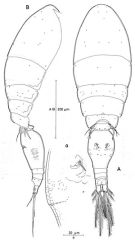 issued from : R. Böttger-Schnack in Mitt. hamb. zool. Mus. Inst., 1999, 96 [p.93, Fig.24]. Female (from Red Sea): A, habitus (dorsal [a, genital aperture and part of genital double-somite, showing surface ornamentation]; B, idem (lateral right side). Nota: Proportional lengths (%) of urosomites and caudal rami 12.8:58.8:7.3:6.4:10.6:11.0. Relative lengths (%) of segments of A1 measured along posterior non-setigerous margin 7:22:45:11:6:9.
|
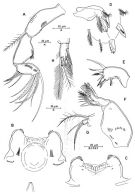 issued from : R. Böttger-Schnack in Mitt. hamb. zool. Mus. Inst., 1999, 96 [p.94, Fig.25). Female: A, A2 (anterior); B, labrum (anterior); C, idem (posterior); D, Md (showing individual elements); E, Mx1; F, Mx2; G, P5 (dorsal); H, caudal ramus (dorsal, terminal setae omitted).
|
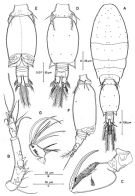 issued from : R. Böttger-Schnack in Mitt. hamb. zool. Mus. Inst., 1999, 96 [p.96, Fig.26]. Male (from Red Sea): A, habitus (dorsal); B, A1; C, Mxp (anterior); D, urosome (dorsal); E, idem (ventral, spermatophores fully developed); F, idem (lateral right side , spermatophores immature); G, A2 (distal endopod segment). Nota: Proportional lengths (%) of urosomites and caudal rami 11.2:57.4:3.6:3.6:3.6:9.4:11.2. Relative lengths (%) of segments of A1 measured along posterior non-setigerous margin 6.6:24.7:42.3:26.4.
Males were assigned to T. umerus on the length of the terminal accessory seta on caudal ramus, which is longer than the dorsal seta. Males of T. minuta also share this character, but can be distinguished by the length ratio of outer spines on P4 endopd-3, bydifferences in the armature of P5 exopod and by the pore pattern on the dorsal surface of the genital double-somite.
|
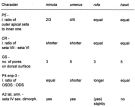 issued from : R. Böttger-Schnack in Mitt. hamb. zool. Mus. Inst., 1999, 96 [p.77, Table 3]. Morphological characters separating males of Triconia minuta, T. umerus, T.rufa and T. hawii. ODS = outer distal spine; OSDS = outer subdistal spine; endp-3 = 3th endopod segment; l = length; sex dimorph. = sexually dimorphic; GS = genital somite; P4, P5 = thoracopods 4, 5; A2 = antenna; CR = caudal rami; lat. arm = lateral armature.
|
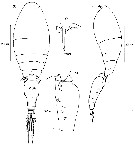 issued from : J.-H. Wi, K.-S. Shih & H.Y. Soh in Zool. Studies, 2011, 50 (5). [p.596, Fig.5]. Female (from 126°5'E, 32°00N): A-B, habitus (dorsal and lateral, respectively); C, genital double-somite (right side); D, genital aperture.
|
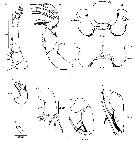 issued from : J.-H. Wi, K.-S. Shih & H.Y. Soh in Zool. Studies, 2011, 50 (5). [p.597, Fig.6]. Female: A, A1; B, A2; C, labrum (anterior); D, labrum (posterior), arrows indicating round shape of the mid-outer margins of the lobes; E, Md; F, dorsal blade on ghathobase of Md; G, Mx1; H, H, Mxp; I, nasis of Mxp, lacking proximal seta.
|
 issued from : J.-H. Wi, K.-S. Shih & H.Y. Soh in Zool. Studies, 2011, 50 (5). [p.5998, Fig.7]. Female: A-D, P1 to P4, respectively (posterior views).
|
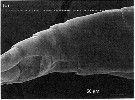 issued from : J.-H. Wi, K.-S. Shih & H.Y. Soh in Zool. Studies, 2011, 50 (5). [p.602, Fig.9, C]. Female (SEM photograph): C, posterior part of genital double-somite and last part of urosome (dorsolateral view).
|
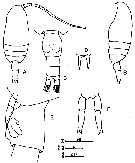 issued from : J.-H. Wi, K.-S. Shih & H.Y. Soh in Zool. Studies, 2011, 50 (5). [p.602, Fig.9, D, E]. Female (SEM photographs): D, middle and lateral part of genital double-somite with denticles; E, genital aperture (left side), with a small spinule at the base of the spine
|
 issued from : J.-H. Wi, K.-S. Shih & H.Y. Soh in Zool. Studies, 2011, 50 (5). [p.600, Fig.8]. Male: A-B, habitus (dorsal and lateral, respectively); C, urosome (ventral); D, P6 and genital flap (right lateral); E, A1; F, A2 (proximal and distal endopodal segments); G, Mxp; H, posterior part of basis of Mxp; I, P2 (distal part of endopodal segment 3).
|
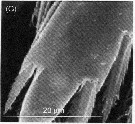 issued from : J.-H. Wi, K.-S. Shih & H.Y. Soh in Zool. Studies, 2011, 50 (5). [p.602, Fig.9, G]. Male (SEM photograph): G, P2 (distal endopodal segment ornamented with denticles).
|
 Issued from : H.Y. Soh, S.Y. Moon & J.H. Wi in Invertebrate Fauna of Korea (eds) Incheon: NIBR, 2013, 21 (28). [p.131, Fig.75]. Female (from Korean waters): A, habitus (dorsal); B, P5 on last thoracic segment and genital segment (lateral);, right side); C, Md; D, Mx1; E, Mxp; F, P2; G, P3; H, P4. Scale bars: A = 200 µm; B, E = 100 µm; C, D = 20Mm; F-H = 20 µm.
|
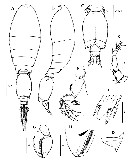 Issued from : H.Y. Soh, S.Y. Moon & J.H. Wi in Invertebrate Fauna of Korea (eds) Incheon: NIBR, 2013, 21 (28). [p.132, Fig.76]. Male: A-B, habitus (dorsal and lateral, respectively); C, urosome (dorsal); D, P6 (lateral view); E , A1; F, A2; G, H, Mxp; I, portion of distal endopodal segment of P2. Scale bars: A, B = 100 µm; C, D, F = 50 µm; E, I = 20 µm; G, H = 25 µm.
| | | | | Ref. compl.: | | | McKinnon & al., 2008 (p.844:Tab.I, p.848: Tab. IV); Nishibe & al., 2009 (p.491, Table 1: seasonal abundance); Böttger-Schnack & Schnack, 2009 (p.131, Table 3, 4); Zenetos & al., 2010 (p.397); Mazzocchi & Di Capua, 2010 (p.429); Tachibana & al., 2013 (p.545, Table 1, seasonal change 2006-2008); Mazzocchi & al., 2014 (p.64, Table 4, 5, abundance); Benedetti & al., 2016 (p.159, Table I, fig.1, functional characters); | | | | NZ: | 6 | | |
|
Carte de distribution de Triconia umerus par zones géographiques
|
| | | | | | | | | | | | | Loc: | | | Medit. (Alboran Sea, Strait of Sicily, Ionian Sea, Lebanon Sea), G. of Aqaba, Red Sea (N-S), G. of Aden, Arabian Sea, Australia (North West Cape), China Seas (East China Sea), Korea, Japan (Tokyo Bay, Tosa Bay, Oyashio region) | | | | N: | 20 | | | | Lg.: | | | (688) F: 0,62-0,57; (810) M: 0,52; (1014) F: 0,580; (1174) F: 0,65-0,71; M: 0,52-0,57; {F: 0,57-0,71; M: 0,52-057} | | | | Rem.: | mésopélagique. Epipelagique dans le Golfe de Naples.
Voir aussi les remarques en anglais | | | Dernière mise à jour : 21/02/2018 | |
|
|
 Toute utilisation de ce site pour une publication sera mentionnée avec la référence suivante : Toute utilisation de ce site pour une publication sera mentionnée avec la référence suivante :
Razouls C., Desreumaux N., Kouwenberg J. et de Bovée F., 2005-2025. - Biodiversité des Copépodes planctoniques marins (morphologie, répartition géographique et données biologiques). Sorbonne Université, CNRS. Disponible sur http://copepodes.obs-banyuls.fr [Accédé le 02 décembre 2025] © copyright 2005-2025 Sorbonne Université, CNRS
|
|
 |
 |
















